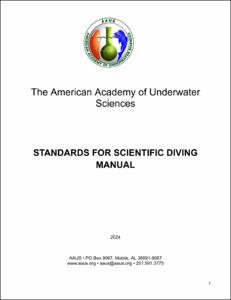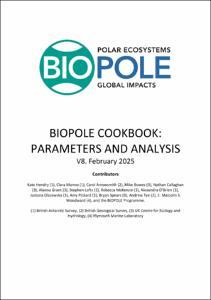OBPS: Recent submissions
Now showing items 1-20 of 2119
-
SOCAT Quality Control Cookbook - for version 2025 of the Surface Ocean CO 2 Atlas.
(SOCAT, 2025)This is the SOCAT quality control (QC) cookbook for SOCAT version 2025. It is an update to the cookbooks for version 1 (Olsen and Metzl, 2009), version 3 (Olsen et al., 2015; Wanninkhof et al., 2013) and version 2019 ... -
Citizen science in eDNA monitoring for Mediterranean monk seal conservation.
(2024)Background Citizen Science (CS) offers a promising approach to enhance data collection and engage communities in conservation efforts. This study evaluates the use of CS in environmental DNA (eDNA) monitoring for Mediterranean ... -
IHO Standards for Hydrographic Surveys, Edition 6.2.0.
(International Hydrographic Organization, Monaco, 2024)This publication aims to provide a set of standards for hydrographic surveys primarily used to compile navigational charts essential for the safety of navigation, knowledge and the protection of the marine environment. ... -
The Nansen Legacy Sampling Protocols, Version 10.
(Septentrio Academic Publishing, Tromso, Norway, 2022)The collection of detailed sampling protocols is crucial tool for the success of the Nansen Legacy, because they ensure: Methodological agreement between the involved researchers Continuity and comparable data ... -
Report on the integration with Data Aggregators: MINKE Deliverable 3.5. Version 1.1.
(Metrology for Integrated Marine Management and Knowledge-Transfer Network (MINKE), 2025)This document is MINKE’s Deliverable 3.5 "Report on the Integration with Data Aggregators." It describes a publication workflow designed to integrate metrologically-aware datasets into trusted repositories and European ... -
EOSC services for harmonised data access and guidance. MINKE Deliverable D3.3. Version 1.0.
(Metrology for Integrated Marine Management and Knowledge-Transfer Network (MINKE), 2023)This document is MINKE’s Deliverable 3.3 “EOSC services for harmonised data access and guidance”. It describes a data publication workflow identified as part of the MINKE project in order to share sensor quality information ... -
The shallow underwater forests of Cystoseira s.l. in the Balearic Islands.
(MedGardens - Cleanwave Foundation, Mallorca, Spain, 2023)The forests composed of Cystoseira sensu lato (hereinafter Cystoseira s.l.) are largely unknown, even though they are very common habitats on our coasts and provide important services to society. Unfortunately, these ... -
Report on the statuses of harmonization and interoperability in the current Calibration-Validation landscape for ocean variables. (D2.4). Version 1.0.
(Metrology for Integrated Marine Management and Knowledge-Transfer Network (MINKE), 2025)This report compiles and reviews information on the breadth and quality of the European calibration-validation landscape in the field of marine observation. It summarizes the exchanges conducted during the MINKE project ... -
Report on the advances in sound measurement methods. MINKE Deliverable D9.9. Version 1.0.
(Metrology for Integrated Marine Management and Knowledge-Transfer Network (MINKE), 2025)This report (MINKE D9.9) explores the current challenges and advances in underwater sound measurement for environmental monitoring. It highlights the importance of accurate sound level measurements in marine environments ... -
Report on improved procedures from O2 sensor purchase to data dissemination . MINKE Deliverable D9.7. Version 1.0.
(Metrology for Integrated Marine Management and Knowledge-Transfer Network (MINKE), 2024)This document provides a comprehensive end-to-end guide for the selection, deployment, calibration, data management, and dissemination of dissolved oxygen (O₂) sensors in oceanographic monitoring. It outlines five major ... -
In situ deployment of sensors for at least two parameters characterizing the carbonate system. MINKE Deliverable D9.11. Version 2.0.
(Metrology for Integrated Marine Management and Knowledge-Transfer Network (MINKE), 2025)This deliverable presents the outcomes of an inter-laboratory comparison (ILC) held in Marseille in November 2023, focused on in situ pH measurement using various sensor types. The ILC involved the deployment of 15 instruments ... -
Best Practice Guidance on Handling Uncertainty Information. MINKE Deliverable D 3.4. Version 1.0.
(Metrology for Integrated Marine Management and Knowledge-Transfer Network (MINKE), 2024)This document is MINKE’s Deliverable 3.4 "Best Practice Guidance on Handling Uncertainty Information." Its main purpose is to define a best practice approach for encoding and applying uncertainty information in oceanographic ... -
Report presenting the data quality aspects in relation with the submission mechanism requested to report towards the SDG indicator 14.3.1. MINKE Deliverable 9.12.
(Metrology for Integrated Marine Management and Knowledge-Transfer Network (MINKE), 2025)This document is MINKE’s Deliverable 9.12 “Report presenting the data quality aspects in relation with the submission mechanism requested to report towards the SDG indicator 14.3.1”. It describes MINKE perspectives on the ... -
Protocol for Spectrophotometric Total pH Measurement. [Training Video]
(Metrology for Integrated Marine Management and Knowledge-Transfer Network (MINKE), 2025)This 6-minute instructional video demonstrates the laboratory protocol for spectrophotometric measurement of total pH (pH<sub>T</sub>) in seawater. The procedure is carried out at the IFREMER metrology laboratory and follows ... -
Best practices sharing between networks. MINKE Deliverable 4.6.
(Metrology for Integrated Marine Management and Knowledge-Transfer Network (MINKE), 2023)MINKE is the first effort to bring together different actors in the metrology laboratories and the diverse marine metrology community. Best Practices are being developed throughout the project and are being shared between ... -
A strategy forward document describing the way forward towards an integrated EU Research Infrastructure. MINKE Deliverable D1.3.
(Metrology for Integrated Marine Management and Knowledge-Transfer Network (MINKE), 2025)This document is the deliverable D1.3 “A strategy forward document describing the way forward towards an integrated EU Research Infrastructure”. It first establishes the ins and outs of marine data and information quality ... -
American Academy of Underwater Sciences Standards for Scientific Diving Manual.
(American Academy of Underwater Sciences (AAUS), Mobile, AL, 2024)The purpose of these Scientific Diving Standards is to ensure scientific diving is conducted in a manner that will maximize the protection of scientific divers from accidental injury and/or illness, and to set forth standards ... -
White paper on advances in Absolute Salinity measurements.Version 4.0. MINKE Deliverable 9.1.
(Metrology for Integrated Marine Management and Knowledge-Transfer Network (MINKE), 2022)This document is MINKE’s Deliverable 9.1: “White paper on advances in Absolute Salinity measurements”. It describes the state-of-the-art in the measurement of Absolute Salinity in seawater. -
Towards a best practice in acoustic telemetry mooring design.
(Ocean Tracking Network (OTN) and Integrated Marine Observing System (IMOS), Dalhouse, Canada, 2025)This document presents trialled and tested, best practice methods for the subsea deployment of acoustic telemetry equipment developed by two of the world’s longest operating animal telemetry networks, the Ocean Tracking ... -
BIOPOLE Cookbook: parameters and analysis, Version 8.
(BIOPOLE Programme, UKRI NERC, Swindon, UK, 2025)The aim of this document is to detail the key determinands, sampling preparation, methodology and analyses required for the NERC programme BIOPOLE, with the overall objective of maintaining consistency in different sampling ...
 Repository of community practices in Ocean Research, Applications and Data/Information Management
Repository of community practices in Ocean Research, Applications and Data/Information Management



















